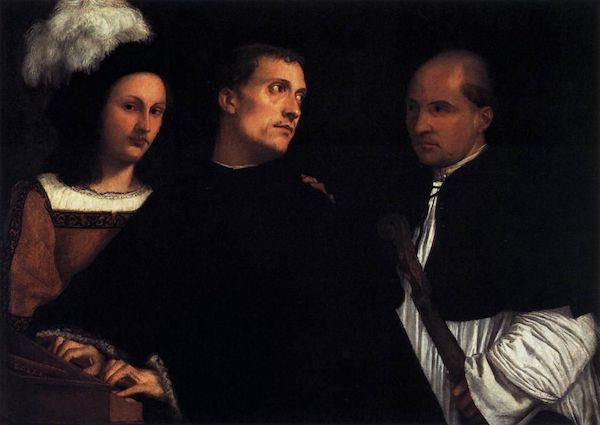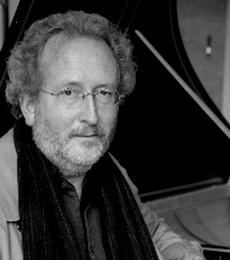Harpsichordist Wilson fascinatingly blends Venetian art and music for Capriccio Baroque

“The Concert” by Titian, c.1510.
As a follow-up to Naoko Akutagawa’s recital of late baroque harpsichord music, Capriccio Baroque presented her husband, Glen Wilson, in music even more obscure on Saturday night.
Focusing on Adriaan Willaert, a composer at the cusp between the late Renaissance and the early baroque, Wilson presented a lecture-recital to a small audience in the home of Capriccio Baroque’s executive director, Carolyn Winter. Only an intimate series like Capriccio Baroque could have successfully carried off a program like this one.
Wilson, an American who was a pioneer in the early music movement, made his name playing the harpsichord with groups like the Leonhardt Consort, Concentus Musicus Wien, La Petite Bande, and others. As he explained in his introduction to this erudite program, he suffered a stroke a few years ago. Although officially he does not give concerts anymore, his intellect and musical acumen proved as strong as ever.
Wilson began by making connections between music and painting in late Renaissance Venice. It turns out that Titian, the Venetian master of color, was an amateur musician. Just as he and other Italian oil painters had been influenced by northern adherents of that medium, Titian knew and admired Adriaan Willaert. The Flemish composer, who had come to Italy, eventually served as music master at the Basilica of San Marco, where he established a Venetian musical style as celebrated as Titian’s in art.
Referring to a set of color postcards given to each person in the small audience, Wilson spoke first about The Concert, painted by Titian around 1510. It shows a black-robed musician in the act of playing an ottavino, the miniature keyboard instrument so named because it sounds an octave higher than the harpsichord. Wilson brought this painting to life by playing three brief pieces on an ottavino built by Colin Booth. Wilson’s large hands drew forth a sweet, tinkly sound on these secular trifles, transcribed from a Venetian manuscript copied about a decade after Titian’s painting.

Glen Wilson performed a lecture-recital for Capriccio Baroque Saturday night.
With scholarly exactitude, Wilson filled out the story of this painting. He posited that the ottavino player was a musician known to Titian, an organist at San Marco named Dionisio Memo, possibly shown at the moment when he was called from Venice into the service of Henry VIII, king of England. Another musician, perhaps playing with him just a moment before, holds the neck of his viol in one hand and draws his colleague’s attention to the well-dressed courtier who has appeared behind him.
In The Wedding at Cana, painted by Paolo Veronese for the refectory of the San Giorgio monastery at the edge of Venice, Wilson pointed out that a violone player in red, shown in the foreground, is a portrait of Titian. In fact the group of musicians providing entertainment in the painting are all leading figures of Venetian music, literature, and painting. Wilson believes that one of the men in this group, hitherto unidentified, is none other than Willaert.
Titian was acquainted with Willaert, having met him in Ferrara in 1516. Titian included an homage to his friend in his painting The Bacchanal of the Andrians, which he painted in Ferrara, notating a Willaert chanson on a scrap of staff paper fallen on the ground. Wilson leans on this connection to identify a portrait in the Art Institute of Chicago, attributed to Jacopo Palma il Giovane, as instead a portrait of Willaert, made by his friend, Titian. The scrap of paper held in the subject’s right hand, pointed at with his left, is another scrap of staff paper with music notated on it.
Wilson then performed a selection of six ricercars by Willaert, four in three parts and two in four parts, abstruse contrapuntal works dating from the 1540s. Listening to these complex imitative pieces, played with gossamer clarity on a harpsichord made by William Dowd, was akin to tracing the colored threads woven together in a tapestry or rug. The ear could follow each thread individually, even as a sort of collective image arose from their intermingling.
Adding a touch of whimsy after this learned demonstration, Wilson offered two charming American selections in a much lighter style. Alexander Reinagle, a composer who came to the United States in 1786, founded an early concert series attended by George Washington, among others. Reinagle’s chipper tune, “Mrs. Madison’s Minuet,” was full of cheer, alas not accompanied by Mr. Madison’s crystal flute from the Library of Congress, which has caused such a stir in recent days.
Harpsichordist Jean Rondeau will perform Bach’s Goldberg Variations 7:30 p.m. October 26. capricciobaroque.org



